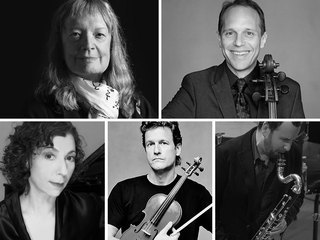|
Back
Epiphany on 37th Street New York
Jerome Robbins Theater, Baryshnikov Arts Center
02/22/2018 -
Olivier Messiaen: Quatuor pour la fin du Temps
Joshua Rubin (Clarinet), Geoff Nuttall (Violin), Christopher Costanza (Cello), Sarah Rothenberg (Piano, Director)
Jennifer Tipton (Lighting Designer)

A Background for Quartet for the End of Time
(© Baryshnikov Arts Center)
“In my dreams, I hear chords and melodies, colors and forms. Then I pass into unreality and submit to an ecstasy, a wheeling, a gyrating interpenetration of superhuman colors. These swords of fire, these blue and orange lava flows, those shooting stars. Here is the whirlwind, these are the rainbows.”
Olivier Messiaen describing Part VII of Quatuor pour la fin du Temps
Unlike Liszt, Scriabin and Rimsky-Korsakov, Olivier Messiaen never concealed his synaesthesia, was never ashamed to “see” colors while he was writing notes. Other composers (even Sibelius) confessed their enchanting malady to close friends or hinted colorful resemblances in their music. Messiaen, appended his visual auras to a codex of allusions which encompasses Tristan and birdsong, Catholic revelation and Hindu mysticism.
Using this knowledge literally for a performance of Quartet for the End of Time might have– could have–destroyed this, one of the greatest chamber works of the 20th Century. A lighting designer aware of his/her genius to emblazon music could have issued holograms of trumpets, whirling figures of Jesus or birds in a dazzling murmuration of flight. Impressive, yes, Messiaen, no.
New York’s iconic lighting designer, Jennifer Tipton, might have been tipped off by director Sarah Rothenberg or might researched Messiaen’s secret:
“I don’t see colors with my eyes. I see colors intellectually in my head.”
I like to think, though, that Ms. Tipton’s color scheme last night in the Baryshnikov Center was an instinctive understanding of the music. That Messiaen’s oracular, almost Delphian writings were never seen literally (okay, the bird-songs were real bird-songs) but were indications of Inner Truths.
Thus Ms. Tipton didn’t create a light-scape for the music. Each of the seven movements, written on the bleu céleste screen heralded the simplest motifs. One was a huge orb over a series of changing colors. The most complex was like a static cirrus wisp of cloud, which later floated off the screen. She sometimes had a blatant series of color bands, like the old television light-testing screens. More often the colors were pastel or light or–and this was the genius–gradually, oh so gradually changing. Her dark orb became lighter, then radiant with radiance inside radiance, and then darker, dimmer like...well, like “the end of time.”

(Top) J. Tipton, C. Costanza
(Bottom) S. Rothenberg, G. Nuttall, J. Rubin
Recently Ms. Tipton created a complex, ever-changing light phenomena in another production directed by Sarah Rothenberg at the Alliance Française, this a picture of Marcel Proust in his many guises, all of them coming from the imaginative and real Proust mind.
Last night, one could have said that the abstractions on the large screen were Rothko-inspired. But Mark Rothko’s works have an inner luminosity, an inner depth which Ms. Tipton never tried to emulate. In fact, the Messiaen seven-movement Quartet, composed in the dank German prisoner-of-war camp for the only musicians in the area, have that spiritual luminosity only in the sound.
Like Ms. Tipton’s palette, Sarah Rothenberg simplified the “direction”. On the bare stage dwarfed by the background screen, the four instrumentalists had few “patterns.” For the opening bird-call, violinist and clarinetist stood at the extremes of the stage, cello, and piano at the center, as the screen went from dark to dawn’s early light. Usually the group were in the center, the spotlights sometimes on the soloists, or, in a very moving section, Ms. Rothenberg at the piano was seen in silhouette.
Nothing, though, interposed with the music. Without a score, I didn’t know if all the accents and dynamics were kosher. Yet from the first movement, the mood created by these four master musicians certainly had the dynamics right, starting with the dawn of birds, played with such sensitivity by clarinetist Joshua Rubin. This was the only literal picture of the Quartet, with Rubin’s bird against the early-morning cello harmonics and hazy piano chords.
After this, the music progressed from the solo to the highly complex, the four instruments playing with different dynamics, solos darting in and out. Cello and piano playing together (cellist Christopher Costanza and Ms. Rothenberg providing a a magical duo). Ms. Rothenberg was the equal of a tumultuous violin solo, Geoff Nuttall coming on the cusp of stamping his foot on the ground.
This is a work of utmost rapture, in fact romantic rapture. Ms. Rothenberg, who had studied with the composer’s wife, obviously knew that–whatever the sounds of the instruments or the colors on the screen on the spotlights on the performers–the music had to preserve a kind of quantum, where space, movement, and the spaces between the movements of the notes became part of the structure.
We have all heard the Quartet for the End of Time played in concert halls around New York. This concert broadened the music to the use of space and movement and, yes luminosity. As Messiaen had explained, the synaesthesia and luminosity were in the mind. With this performance, the hermetic intellect widened out to a visual and aural similitude for an epiphany.
Harry Rolnick
|